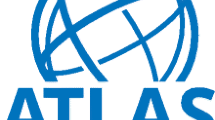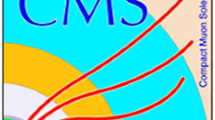Abstract
We study the deep inelastic process ν τ + N → τ − + X (with N ≡ (n + p)/2 an isoscalar nucleon), in the context of the two-Higgs doublet model Type II (2HDM(II)). We discuss the contribution to the total cross-section of diagrams, in which a charged Higgs boson is exchanged. We present results which show strong dependence of such contributions on tan β and M H ±. We show that for tan β ≈ 150 and M H ± ≈ 300 GeV, the contribution of the charged Higgs boson exchange diagrams to the cross-section of the charged current inclusive ν τ N collision can become important. We find that this contribution for an inclusive dispersion generated through the collision of an ultra-high-energy tau-neutrino with E ν ≈ 1021 eV on a target nucleon can be as large as 40% of the value of the contribution of the W ± exchange diagrams, provided M H ± ≈ 300 GeV and tan β ≈ 150. Such enhancement and the induced variation on the mean inelasticity 〈y〉CC could lead to sizeable effects in the acceptance of cosmic tau-neutrino detectors at experiments such as HiRes, PAO, and the CRTNT, which are anchored to the ground, and at experiments such as EUSO and OWL, which are proposed to orbit around the Earth. We also compare the contribution to σ tot H+ from the different allowed initial quarks and we show that the contribution from the bottom quark dominates by far. This means that the H ± contribution practically always gives a top quark in the final state. Such a large component of the cross-section having a top quark event in the final state could have recognizable features in the EAS experiments.
Similar content being viewed by others
References
S L Glashow, Nucl. Phys. 22, 579 (1961)
S Weinberg, Phys. Rev. Lett. 19, 1264 (1967)
A Salam, Proc. 8th NOBEL Symposium edited by N Svartholm (Almqvist and Wiksell, Stockholm, 1968) p. 367
J Gunion, H Haber, G Kane and S Dawson, The Higgs hunter’s guide (Addison-Wesley Publishing Company, Reading, MA, 1990)
H E Haber, in Testing the Standard Model, Proceedings of the 1990 Theoretical Advanced Study Institute in Elementary Particle Physics edited by M Cvetic and P Langacker (World Scientific, Singapore, 1991) pp. 340–475
For a recent study of the 2HDM, see: E Accomando et al, arXiv:hep-ph/0608079
V D Barger, J L Hewett and R J N Phillips, Phys. Rev. D41, 3421 (1990)
T D Lee, Phys. Rev. D8, 1226 (1973)
T D Lee, Phys. Rep. 9, 143 (1974)
S Weinberg, Phys. Rev. Lett. 37, 657 (1976)
Y L Wu and L Wolfenstein, Phys. Rev. Lett. 73, 1762 (1994), arXiv:hep-ph/9409421
J Liu and L Wolfenstein, Nucl. Phys. B289, 1 (1987)
ALEPH Collaboration: A Heister et al, Phys. Lett. B543, 1 (2002), arXiv:hep-ex/0207054
OPAL Collaboration: K Ackerstaff et al, Euro. Phys. J. C8, 3 (1999), arXiv:hep-ex/9808016
OPAL Collaboration: G Abbiendi et al., Phys. Lett. B551, 35 (2003), arXiv:hep-ex/0211066
OPAL Collaboration: G Abbiendi et al, Phys. Lett. B520, 1 (2001), arXiv:hep-ex/0108031
CLEO Collaboration: R Ammar et al, Phys. Rev. Lett. 78, 4686 (1997)
A Stahl and H Voss, Z. Phys. C74, 73 (1997)
ALEPH Collaboration: D Buskulic et al, Phys. Lett. B343, 444 (1995)
ALEPH Collaboration: R Barate et al, Euro. Phys. J. C19, 213 (2001), arXiv:hep-ex/0010022
L3 Collaboration: M Acciarri et al, Phys. Lett. B396, 327 (1997)
Belle Collaboration: K Abe et al, arXiv:hep-ex/0507034
M Misiak et al, Phys. Rev. Lett. 98, 022002 (2007), arXiv:hep-ph/0609232
D P Roy, AIP Conf. Proc. 805, 110 (2006), arXiv:hep-ph/0510070
H Baer, J Ferrandis and X Tata, Phys. Lett. B561, 145 (2003), arXiv:hep-ph/0211418
AMANDA Collaboration: E Andres et al, Nature 410, 441 (2001)
ANTARES Collaboration: Y Becherini et al, e-Print Archive: hep-ph/0211173
AUGER Collaboration: D Zavrtanik et al, Nucl. Phys. Proc. Suppl. 85, 324 (2002)
NESTOR Collaboration: P K F Grieder et al, Nuovo Cimento C24, 771 (2001)
RICE Collaboration: I Kravchenko et al, Astropart. Phys. 19, 15 (2003)
V S Beresinsky and G T Zatsepin, Phys. Lett. B28, 423 (1969)
V S Berezinsky and V I Dokuchaev, Nucl. Phys. Proc. Suppl. 110, 522 (2002)
V S Berezinsky, Nucl. Phys. Proc. Suppl. 38, 363 (1995); 31, 413 (1993)
T Stanev, Nucl. Phys. Proc. Suppl. A14, 17 (1990)
K Greisen, Phys. Rev. Lett. 16, 748 (1966)
C T Hill and D N Schramm, Phys. Lett. B131, 247 (1983); Phys. Rev. D31, 564 (1985)
R Gandhi, C Quigg, M H Reno and I Sarcevic, Phys. Rev. D58, 093009 (1998), arXiv:hep-ph/9807264
O Blanch and P Billoir, Acceptance and flux limit for v τ with the Pierre Auger Observatory Surface Detector, preprint LPNHE (Paris, France, September 26, 2005)
X Bertou, P Billoir, O Deligny, C Lachaud and A Letessier-Selvon, Astropart. Phys. 17, 183 (2002); arXiv:astro-ph/0104452
R P Feynman, Photon-hadron interactions (Reading, Benjamin, 1972)
V D Barger and R J N Phillips, Collider physics (updated edition) (Addison-Wesley Publishing Company, Inc., Reading, Massachusetts, 1997)
J Pumplin et al, J. High Energy Phys. 207, 12 (2002)
D Stump et al, e-Print Archive: hep-ph/0303013
E Byckling and K Kajantie, Particle kinematics (Wiley, New York, 1972)
M H Reno and C Quigg, Phys. Rev. D37, 657 (1988)
C Quigg, M H Reno and T P Walker, Phys. Rev. Lett. 57, 774 (1986)
A Rosado, Phys. Rev. D74, 057301 (2006)
Particle Data Group: S Eidelman et al, Phys. Lett. B592, 1 (2004)
S Palomares-Ruiz, A Irimia and T J Weiler, Phys. Rev. D73, 083003 (2006), arXiv:astro-ph/0512231
The HiRes Collaboration: P Sokolsky and J Belz, Comparison of UHE composition measurements by Fly’s Eye, HiRes-prototype/MIA and stereo HiRes experiments, arXiv:astro-ph/0507485
Auger Collaboration: H Blumer et al, The Auger fluorescence detector prototype telescope, FZKA-6345P, Prepared for 26th International Cosmic Ray Conference (ICRC 99), Salt Lake City, UT, 17–25 Aug. 1999
Pierre Auger Collaboration: J Abraham et al, Nucl. Instrum. Methods A523, 50 (2004)
Z Cao, Nucl. Phys. Proc. Suppl. 151, 287 (2006)
The EUSO Collaboration: Ph Gorodetzky, Nucl. Phys. Proc. Suppl. 151, 401 (2006), arXiv:astro-ph/0502187
EUSO Collaboration: G D’Ali Staiti, Nucl. Phys. Proc. Suppl. 136, 415 (2004)
F W Stecker, J F Krizmanic, L M Barbier, E Loh, J W Mitchell, P Sokolsky and R E Streitmatter, Nucl. Phys. Proc. Suppl. C136, 433 (2004), arXiv:astro-ph/0408162
E Zas, New J. Phys. 7, 130 (2005), arXiv:astro-ph/0504610
R Gandhi, C Quigg, M H Reno and I Sarcevic, Astropart. Phys. 5, 81 (1996), arXiv:hep-ph/9512364
J C Arteaga-Velazquez and A Zepeda, Estimation of the detectable flux of astrophysical neutrinos at the Pierre Auger Observatory by means of horizontal air showers, Proceedings of 29th International Cosmic Ray Conference, Pune, 2005, vol. 9, pp. 151–154
C Aramo, A Insolia, A Leonardi, G Miele, L Perrone, O Pisanti and D V Semikoz, Astropart. Phys. 23, 65 (2005), arXiv:astro-ph/0407638
Author information
Authors and Affiliations
Corresponding author
Rights and permissions
About this article
Cite this article
Pedraza-Morales, M.I., Rosado, A. & Salazar, H. Effects of charged Higgs bosons in the deep inelastic process ν τ N → τ − X and the possibility of detecting tau-neutrinos at cosmic neutrino detectors. Pramana - J Phys 70, 603–615 (2008). https://doi.org/10.1007/s12043-008-0022-3
Received:
Revised:
Accepted:
Published:
Issue Date:
DOI: https://doi.org/10.1007/s12043-008-0022-3




